这篇文章给大家介绍C++中怎么使用智能指针,内容非常详细,感兴趣的小伙伴们可以参考借鉴,希望对大家能有所帮助。
一、为什么要使用智能指针
一句话带过:智能指针就是帮我们C++程序员管理动态分配的内存的,它会帮助我们自动释放new出来的内存,从而避免内存泄漏!
如下例子就是内存泄露的例子:
#include <iostream>#include <string>#include <memory>using namespace std;// 动态分配内存,没有释放就returnvoid memoryLeak1() {string *str = new string("动态分配内存!");return;}// 动态分配内存,虽然有些释放内存的代码,但是被半路截胡return了int memoryLeak2() {string *str = new string("内存泄露!");// ...此处省略一万行代码// 发生某些异常,需要结束函数if (1) {return -1;}delete str;// 虽然写了释放内存的代码,但是遭到函数中段返回,使得指针没有得到释放return 1;}int main(void) {memoryLeak1();memoryLeak2();return 0;}memoryLeak1函数中,new了一个字符串指针,但是没有delete就已经return结束函数了,导致内存没有被释放,内存泄露!
memoryLeak2函数中,new了一个字符串指针,虽然在函数末尾有些释放内存的代码delete str,但是在delete之前就已经return了,所以内存也没有被释放,内存泄露!
使用指针,我们没有释放,就会造成内存泄露。但是我们使用普通对象却不会!
思考:如果我们分配的动态内存都交由有生命周期的对象来处理,那么在对象过期时,让它的析构函数删除指向的内存,这看似是一个 very nice 的方案?
智能指针就是通过这个原理来解决指针自动释放的问题!
C++98 提供了 auto_ptr 模板的解决方案
C++11 增加unique_ptr、shared_ptr 和weak_ptr
二、auto_ptr
auto_ptr 是c++ 98定义的智能指针模板,其定义了管理指针的对象,可以将new 获得(直接或间接)的地址赋给这种对象。当对象过期时,其析构函数将使用delete 来释放内存!
用法:
头文件: #include < memory >
用 法: auto_ptr<类型> 变量名(new 类型)
例 如:
auto_ptr< string > str(new string(“我要成为大牛~ 变得很牛逼!”));
auto_ptr<vector< int >> av(new vector< int >());
auto_ptr< int > array(new int[10]);
例:
我们先定义一个类,类的构造函数和析构函数都输出一个字符串用作提示!
定义一个私有成员变量,赋值20.
再定义一个私有成员方法用于返回这个私有成员变量。
class Test {public:Test() { cout << "Test的构造函数..." << endl; }~Test() { cout << "Test的析构函数..." << endl; }int getDebug() { return this->debug; }private:int debug = 20;};当我们直接new这个类的对象,却没有释放时。。。
int main(void) {Test *test = new Test;return 0;}
可以看到,只是打印了构造函数这个字符串,而析构函数的字符却没有被打印,说明并没有调用析构函数!这就导致了内存泄露!
解决内存泄露的办法,要么手动delete,要么使用智能指针!
使用智能指针:
// 定义智能指针auto_ptr<Test> test(new Test);智能指针可以像普通指针那样使用:
cout << "test->debug:" << test->getDebug() << endl;cout << "(*test).debug:" << (*test).getDebug() << endl;这时再试试:
int main(void) {//Test *test = new Test;auto_ptr<Test> test(new Test);cout << "test->debug:" << test->getDebug() << endl;cout << "(*test).debug:" << (*test).getDebug() << endl;return 0;}
自动调用了析构函数。
为什么智能指针可以像普通指针那样使用???
因为其里面重载了 * 和 -> 运算符, * 返回普通对象,而 -> 返回指针对象。

具体原因不用深究,只需知道他为什么可以这样操作就像!
函数中返回的是调用get()方法返回的值,那么这个get()是什么呢?
智能指针的三个常用函数:
get() 获取智能指针托管的指针地址
// 定义智能指针auto_ptr<Test> test(new Test);Test *tmp = test.get();// 获取指针返回cout << "tmp->debug:" << tmp->getDebug() << endl;但我们一般不会这样使用,因为都可以直接使用智能指针去操作,除非有一些特殊情况。
函数原型:
_NODISCARD _Ty * get() const noexcept{// return wrapped pointerreturn (_Myptr);}release() 取消智能指针对动态内存的托管
// 定义智能指针auto_ptr<Test> test(new Test);Test *tmp2 = test.release();// 取消智能指针对动态内存的托管delete tmp2;// 之前分配的内存需要自己手动释放也就是智能指针不再对该指针进行管理,改由管理员进行管理!
函数原型:
_Ty * release() noexcept{// return wrapped pointer and give up ownership_Ty * _Tmp = _Myptr;_Myptr = nullptr;return (_Tmp);}reset() 重置智能指针托管的内存地址,如果地址不一致,原来的会被析构掉
// 定义智能指针auto_ptr<Test> test(new Test);test.reset();// 释放掉智能指针托管的指针内存,并将其置NULLtest.reset(new Test());// 释放掉智能指针托管的指针内存,并将参数指针取代之reset函数会将参数的指针(不指定则为NULL),与托管的指针比较,如果地址不一致,那么就会析构掉原来托管的指针,然后使用参数的指针替代之。然后智能指针就会托管参数的那个指针了。
函数原型:
void reset(_Ty * _Ptr = nullptr){// destroy designated object and store new pointerif (_Ptr != _Myptr)delete _Myptr;_Myptr = _Ptr;}使用建议:
尽可能不要将auto_ptr 变量定义为全局变量或指针;
// 没有意义,全局变量也是一样auto_ptr<Test> *tp = new auto_ptr<Test>(new Test);除非自己知道后果,不要把auto_ptr 智能指针赋值给同类型的另外一个 智能指针;
auto_ptr<Test> t1(new Test);auto_ptr<Test> t2(new Test);t1 = t2;// 不要这样操作...C++11 后auto_ptr 已经被“抛弃”,已使用unique_ptr替代!C++11后不建议使用auto_ptr。
auto_ptr 被C++11抛弃的主要原因
1). 复制或者赋值都会改变资源的所有权
// auto_ptr 被C++11抛弃的主要原因auto_ptr<string> p1(new string("I'm Li Ming!"));auto_ptr<string> p2(new string("I'm age 22."));cout << "p1:" << p1.get() << endl;cout << "p2:" << p2.get() << endl;// p2赋值给p1后,首先p1会先将自己原先托管的指针释放掉,然后接收托管p2所托管的指针,// 然后p2所托管的指针制NULL,也就是p1托管了p2托管的指针,而p2放弃了托管。p1 = p2;cout << "p1 = p2 赋值后:" << endl;cout << "p1:" << p1.get() << endl;cout << "p2:" << p2.get() << endl;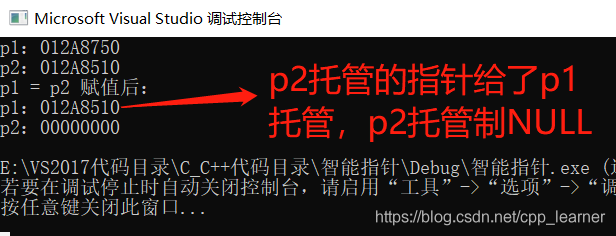
2). 在STL容器中使用auto_ptr存在着重大风险,因为容器内的元素必须支持可复制和可赋值
vector<auto_ptr<string>> vec;auto_ptr<string> p3(new string("I'm P3"));auto_ptr<string> p4(new string("I'm P4"));// 必须使用std::move修饰成右值,才可以进行插入容器中vec.push_back(std::move(p3));vec.push_back(std::move(p4));cout << "vec.at(0):" << *vec.at(0) << endl;cout << "vec[1]:" << *vec[1] << endl;// 风险来了:vec[0] = vec[1];// 如果进行赋值,问题又回到了上面一个问题中。cout << "vec.at(0):" << *vec.at(0) << endl;cout << "vec[1]:" << *vec[1] << endl;访问越界了!
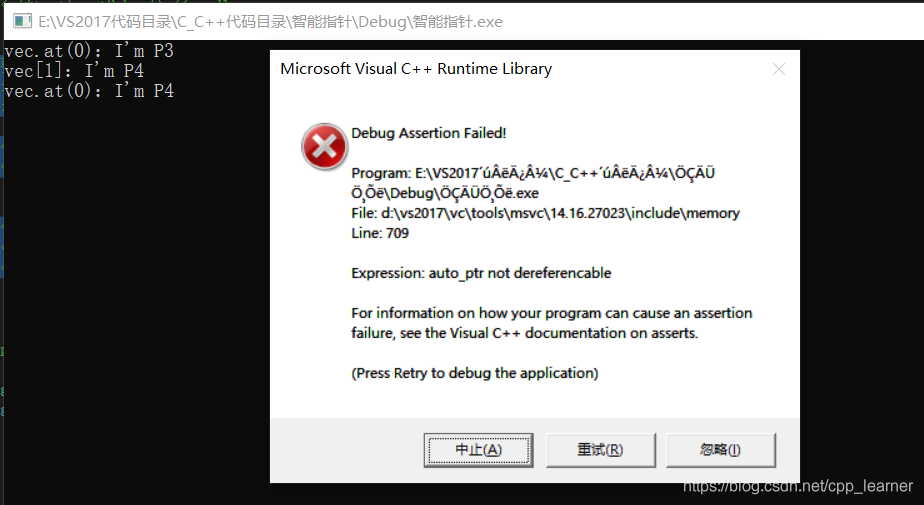
3). 不支持对象数组的内存管理
auto_ptr<int[]> array(new int[5]);// 不能这样定义
所以,C++11用更严谨的unique_ptr 取代了auto_ptr!
测试代码:
#include <iostream>#include <string>#include <memory>#include <vector>using namespace std;class Test {public:Test() { cout << "Test的构造函数..." << endl; }~Test() { cout << "Test的析构函数..." << endl; }int getDebug() { return this->debug; }private:int debug = 20;};// 不要定义为全局变量,没有意义//auto_ptr<Test> test(new Test);void memoryLeak1() {//Test *test = new Test;// 定义智能指针auto_ptr<Test> test(new Test);cout << "test->debug:" << test->getDebug() << endl;cout << "(*test).debug:" << (*test).getDebug() << endl;// get方法Test *tmp = test.get();// 获取指针返回cout << "tmp->debug:" << tmp->getDebug() << endl;// release方法Test *tmp2 = test.release();// 取消智能指针对动态内存的托管delete tmp2;// 之前分配的内存需要自己手动释放// reset方法:重置智能指针托管的内存地址,如果地址不一致,原来的会被析构掉test.reset();// 释放掉智能指针托管的指针内存,并将其置NULLtest.reset(new Test());// 释放掉智能指针托管的指针内存,并将参数指针取代之// 忠告:不要将智能指针定义为指针//auto_ptr<Test> *tp = new auto_ptr<Test>(new Test);// 忠告:不要定义指向智能指针对象的指针变量//auto_ptr<Test> t1(new Test);//auto_ptr<Test> t2(new Test);//t1 = t2;return;}int memoryLeak2() {//Test *test = new Test();// 定义智能指针auto_ptr<Test> test(new Test);// ...此处省略一万行代码// 发生某些异常,需要结束函数if (1) {return -1;}//delete test;return 1;}int main1(void) {//memoryLeak1();//memoryLeak2();//Test *test = new Test;//auto_ptr<Test> test(new Test);//cout << "test->debug:" << test->getDebug() << endl;//cout << "(*test).debug:" << (*test).getDebug() << endl; auto_ptr 被C++11抛弃的主要原因//auto_ptr<string> p1(new string("I'm Li Ming!"));//auto_ptr<string> p2(new string("I'm age 22."));////cout << "p1:" << p1.get() << endl;//cout << "p2:" << p2.get() << endl;//p1 = p2;//cout << "p1 = p2 赋值后:" << endl;//cout << "p1:" << p1.get() << endl;//cout << "p2:" << p2.get() << endl;// 弊端2.在STL容器中使用auto_ptr存在着重大风险,因为容器内的元素必须支持可复制vector<auto_ptr<string>> vec;auto_ptr<string> p3(new string("I'm P3"));auto_ptr<string> p4(new string("I'm P4"));vec.push_back(std::move(p3));vec.push_back(std::move(p4));cout << "vec.at(0):" << *vec.at(0) << endl;cout << "vec[1]:" << *vec[1] << endl;// 风险来了:vec[0] = vec[1];cout << "vec.at(0):" << *vec.at(0) << endl;cout << "vec[1]:" << *vec[1] << endl;// 弊端3.不支持对象数组的内存管理//auto_ptr<int[]> array(new int[5]);// 不能这样定义return 0;}三、unique_ptr
auto_ptr是用于C++11之前的智能指针。由于 auto_ptr 基于排他所有权模式:两个指针不能指向同一个资源,复制或赋值都会改变资源的所有权。auto_ptr 主要有三大问题:
复制和赋值会改变资源的所有权,不符合人的直觉。
在 STL 容器中使用auto_ptr存在重大风险,因为容器内的元素必需支持可复制(copy constructable)和可赋值(assignable)。
不支持对象数组的操作
以上问题已经在上面体现出来了,下面将使用unique_ptr解决这些问题。
所以,C++11用更严谨的unique_ptr 取代了auto_ptr!
unique_ptr 和 auto_ptr用法几乎一样,除了一些特殊。
unique_ptr特性
基于排他所有权模式:两个指针不能指向同一个资源
无法进行左值unique_ptr复制构造,也无法进行左值复制赋值操作,但允许临时右值赋值构造和赋值
保存指向某个对象的指针,当它本身离开作用域时会自动释放它指向的对象。
在容器中保存指针是安全的
A. 无法进行左值复制赋值操作,但允许临时右值赋值构造和赋值
unique_ptr<string> p1(new string("I'm Li Ming!"));unique_ptr<string> p2(new string("I'm age 22."));cout << "p1:" << p1.get() << endl;cout << "p2:" << p2.get() << endl;p1 = p2;// 禁止左值赋值unique_ptr<string> p3(p2);// 禁止左值赋值构造unique_ptr<string> p3(std::move(p1));p1 = std::move(p2);// 使用move把左值转成右值就可以赋值了,效果和auto_ptr赋值一样cout << "p1 = p2 赋值后:" << endl;cout << "p1:" << p1.get() << endl;cout << "p2:" << p2.get() << endl;
运行截图:

B. 在 STL 容器中使用unique_ptr,不允许直接赋值
vector<unique_ptr<string>> vec;unique_ptr<string> p3(new string("I'm P3"));unique_ptr<string> p4(new string("I'm P4"));vec.push_back(std::move(p3));vec.push_back(std::move(p4));cout << "vec.at(0):" << *vec.at(0) << endl;cout << "vec[1]:" << *vec[1] << endl;vec[0] = vec[1];vec[0] = std::move(vec[1]);// 需要使用move修饰,使得程序员知道后果cout << "vec.at(0):" << *vec.at(0) << endl;cout << "vec[1]:" << *vec[1] << endl;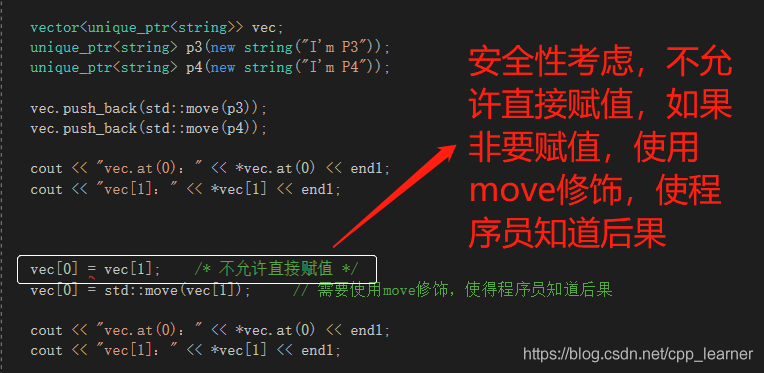
当然,运行后是直接报错的,因为vec[1]已经是NULL了,再继续访问就越界了。
C. 支持对象数组的内存管理
// 会自动调用delete [] 函数去释放内存unique_ptr<int[]> array(new int[5]);// 支持这样定义除了上面ABC三项外,unique_ptr的其余用法都与auto_ptr用法一致。
构造
class Test {public:Test() { cout << "Test的构造函数..." << endl; }~Test() { cout << "Test的析构函数..." << endl; }void doSomething() { cout << "do something......" << endl; }};// 自定义一个内存释放其class DestructTest {public:void operator()(Test *pt) {pt->doSomething();delete pt;}};// unique_ptr<T> up; 空的unique_ptr,可以指向类型为T的对象unique_ptr<Test> t1;// unique_ptr<T> up1(new T());定义unique_ptr,同时指向类型为T的对象unique_ptr<Test> t2(new Test);// unique_ptr<T[]> up;空的unique_ptr,可以指向类型为T[的数组对象unique_ptr<int[]> t3;// unique_ptr<T[]> up1(new T[]);定义unique_ptr,同时指向类型为T的数组对象unique_ptr<int[]> t4(new int[5]);// unique_ptr<T, D> up();空的unique_ptr,接受一个D类型的删除器D,使用D释放内存unique_ptr<Test, DestructTest> t5;// unique_ptr<T, D> up(new T());定义unique_ptr,同时指向类型为T的对象,接受一个D类型的删除器D,使用删除器D来释放内存unique_ptr<Test, DestructTest> t6(new Test);赋值
unique_ptr<Test> t7(new Test);unique_ptr<Test> t8(new Test);t7 = std::move(t8);// 必须使用移动语义,结果,t7的内存释放,t8的内存交给t7管理t7->doSomething();主动释放对象
unique_ptr<Test> t9(new Test);t9 = NULL;t9 = nullptr;t9.reset();放弃对象的控制权
Test *t10 = t9.release();重置
t9.reset(new Test);auto_ptr 与 unique_ptr智能指针的内存管理陷阱
auto_ptr<string> p1;string *str = new string("智能指针的内存管理陷阱");p1.reset(str);// p1托管str指针{auto_ptr<string> p2;p2.reset(str);// p2接管str指针时,会先取消p1的托管,然后再对str的托管}// 此时p1已经没有托管内容指针了,为NULL,在使用它就会内存报错!cout << "str:" << *p1 << endl;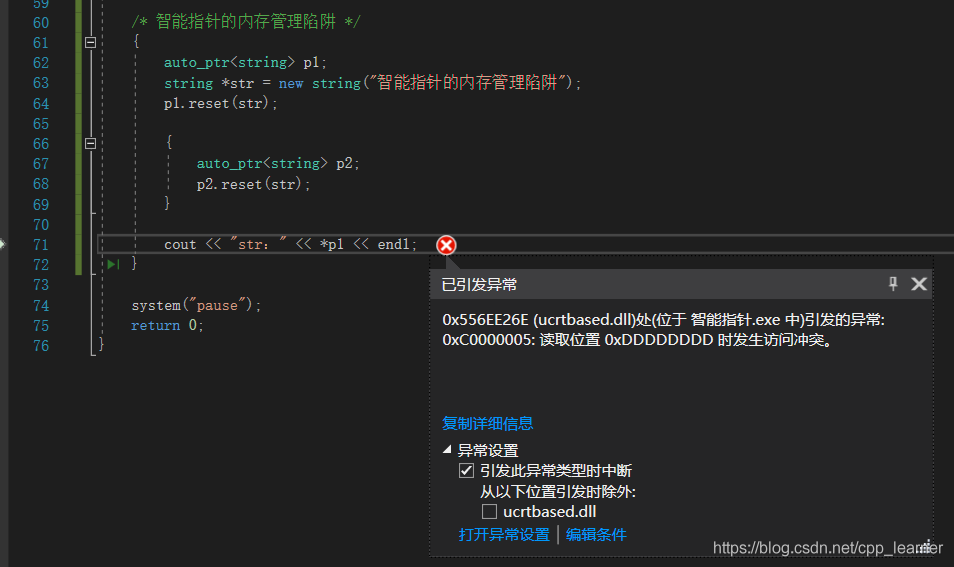
这是由于auto_ptr 与 unique_ptr的排他性所导致的!
为了解决这样的问题,我们可以使用shared_ptr指针指针!
四、shared_ptr
熟悉了unique_ptr 后,其实我们发现unique_ptr 这种排他型的内存管理并不能适应所有情况,有很大的局限!如果需要多个指针变量共享怎么办?
如果有一种方式,可以记录引用特定内存对象的智能指针数量,当复制或拷贝时,引用计数加1,当智能指针析构时,引用计数减1,如果计数为零,代表已经没有指针指向这块内存,那么我们就释放它!这就是 shared_ptr 采用的策略!
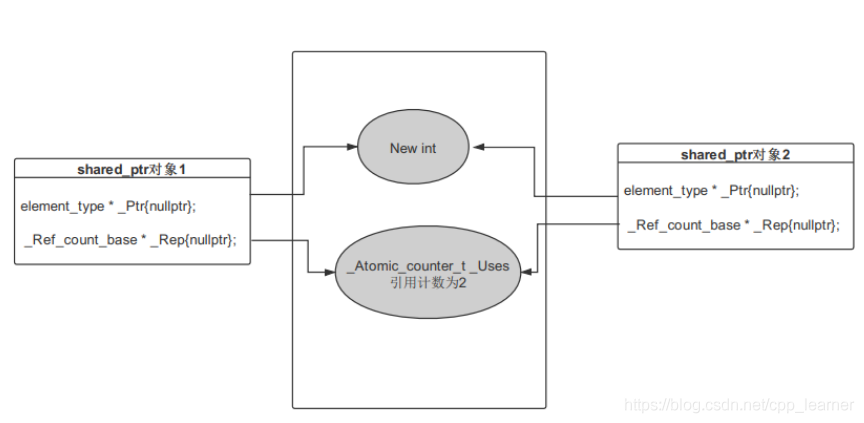
例:
class Person {public:Person(int v) {this->no = v;cout << "构造函数 \t no = " << this->no << endl;}~Person() {cout << "析构函数 \t no = " << this->no << endl;}private:int no;};// 仿函数,内存删除class DestructPerson {public:void operator() (Person *pt) {cout << "DestructPerson..." << endl;delete pt;}};引用计数的使用
调用use_count函数可以获得当前托管指针的引用计数。
shared_ptr<Person> sp1;shared_ptr<Person> sp2(new Person(2));// 获取智能指针管控的共享指针的数量use_count():引用计数cout << "sp1use_count() = " << sp1.use_count() << endl;cout << "sp2use_count() = " << sp2.use_count() << endl << endl;// 共享sp1 = sp2;cout << "sp1use_count() = " << sp1.use_count() << endl;cout << "sp2use_count() = " << sp2.use_count() << endl << endl;shared_ptr<Person> sp3(sp1);cout << "sp1use_count() = " << sp1.use_count() << endl;cout << "sp2use_count() = " << sp2.use_count() << endl;cout << "sp2use_count() = " << sp3.use_count() << endl << endl;如上代码,sp1 = sp2; 和 shared_ptr< Person > sp3(sp1);就是在使用引用计数了。
sp1 = sp2; --> sp1和sp2共同托管同一个指针,所以他们的引用计数为2;
shared_ptr< Person > sp3(sp1); --> sp1和sp2和sp3共同托管同一个指针,所以他们的引用计数为3;
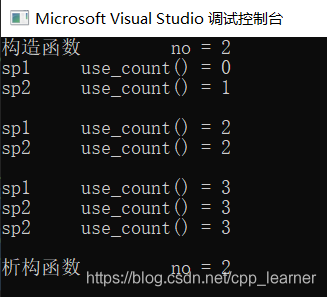
构造
1). shared_ptr< T > sp1; 空的shared_ptr,可以指向类型为T的对象
shared_ptr<Person> sp1;Person *person1 = new Person(1);sp1.reset(person1);// 托管person12). shared_ptr< T > sp2(new T()); 定义shared_ptr,同时指向类型为T的对象
shared_ptr<Person> sp2(new Person(2));shared_ptr<Person> sp3(sp1);3). shared_ptr<T[]> sp4; 空的shared_ptr,可以指向类型为T[]的数组对象 C++17后支持
shared_ptr<Person[]> sp4;4). shared_ptr<T[]> sp5(new T[] { … }); 指向类型为T的数组对象 C++17后支持
shared_ptr<Person[]> sp5(new Person[5] { 3, 4, 5, 6, 7 });5). shared_ptr< T > sp6(NULL, D()); //空的shared_ptr,接受一个D类型的删除器,使用D释放内存
shared_ptr<Person> sp6(NULL, DestructPerson());6). shared_ptr< T > sp7(new T(), D()); //定义shared_ptr,指向类型为T的对象,接受一个D类型的删除器,使用D删除器来释放内存
shared_ptr<Person> sp7(new Person(8), DestructPerson());初始化
1). 方式一:构造函数
shared_ptr<int> up1(new int(10)); // int(10) 的引用计数为1shared_ptr<int> up2(up1); // 使用智能指针up1构造up2, 此时int(10) 引用计数为22). 方式二:使用make_shared 初始化对象,分配内存效率更高(推荐使用)
make_shared函数的主要功能是在动态内存中分配一个对象并初始化它,返回指向此对象的shared_ptr; 用法:
make_shared<类型>(构造类型对象需要的参数列表);
shared_ptr<int> up3 = make_shared<int>(2); // 多个参数以逗号','隔开,最多接受十个shared_ptr<string> up4 = make_shared<string>("字符串");shared_ptr<Person> up5 = make_shared<Person>(9);赋值
shared_ptrr<int> up1(new int(10)); // int(10) 的引用计数为1shared_ptr<int> up2(new int(11)); // int(11) 的引用计数为1up1 = up2;// int(10) 的引用计数减1,计数归零内存释放,up2共享int(11)给up1, int(11)的引用计数为2主动释放对象
shared_ptrr<int> up1(new int(10));up1 = nullptr ;// int(10) 的引用计数减1,计数归零内存释放 // 或up1 = NULL; // 作用同上重置
p.reset() ; 将p重置为空指针,所管理对象引用计数 减1
p.reset(p1); 将p重置为p1(的值),p 管控的对象计数减1,p接管对p1指针的管控
p.reset(p1,d); 将p重置为p1(的值),p 管控的对象计数减1并使用d作为删除器
p1是一个指针!
交换
p1 和 p2 是智能指针
std::swap(p1,p2); // 交换p1 和p2 管理的对象,原对象的引用计数不变p1.swap(p2); // 交换p1 和p2 管理的对象,原对象的引用计数不变shared_ptr使用陷阱
shared_ptr作为被管控的对象的成员时,小心因循环引用造成无法释放资源!
如下代码:
Boy类中有Girl的智能指针;
Girl类中有Boy的智能指针;
当他们交叉互相持有对方的管理对象时…
#include <iostream>#include <string>#include <memory>using namespace std;class Girl;class Boy {public:Boy() {cout << "Boy 构造函数" << endl;}~Boy() {cout << "~Boy 析构函数" << endl;}void setGirlFriend(shared_ptr<Girl> _girlFriend) {this->girlFriend = _girlFriend;}private:shared_ptr<Girl> girlFriend;};class Girl {public:Girl() {cout << "Girl 构造函数" << endl;}~Girl() {cout << "~Girl 析构函数" << endl;}void setBoyFriend(shared_ptr<Boy> _boyFriend) {this->boyFriend = _boyFriend;}private:shared_ptr<Boy> boyFriend;};void useTrap() {shared_ptr<Boy> spBoy(new Boy());shared_ptr<Girl> spGirl(new Girl());// 陷阱用法spBoy->setGirlFriend(spGirl);spGirl->setBoyFriend(spBoy);// 此时boy和girl的引用计数都是2}int main(void) {useTrap();system("pause");return 0;}运行截图:
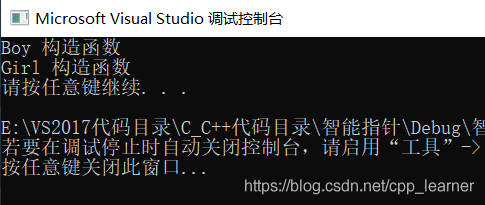
可以看出,程序结束了,但是并没有释放内存,这是为什么呢???
如下图:
当我们执行useTrap函数时,注意,是没有结束此函数,boy和girl指针其实是被两个智能指针托管的,所以他们的引用计数是2
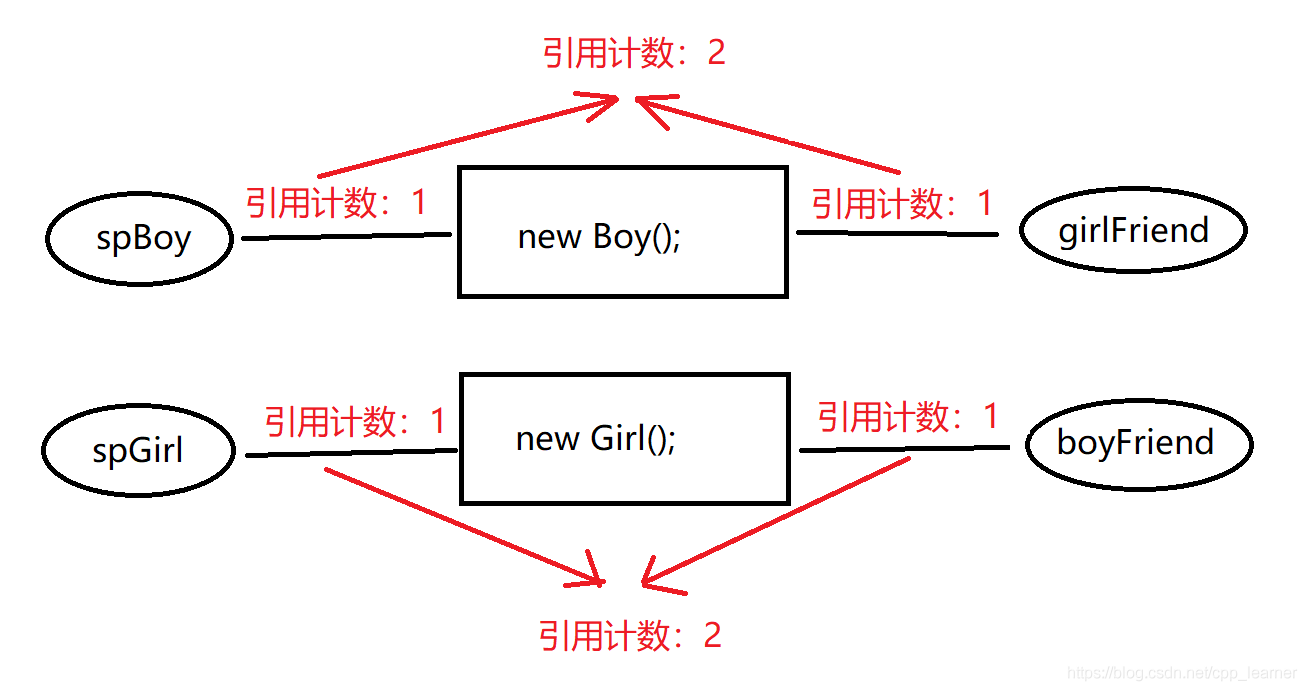
useTrap函数结束后,函数中定义的智能指针被清掉,boy和girl指针的引用计数减1,还剩下1,对象中的智能指针还是托管他们的,所以函数结束后没有将boy和gilr指针释放的原因就是于此。
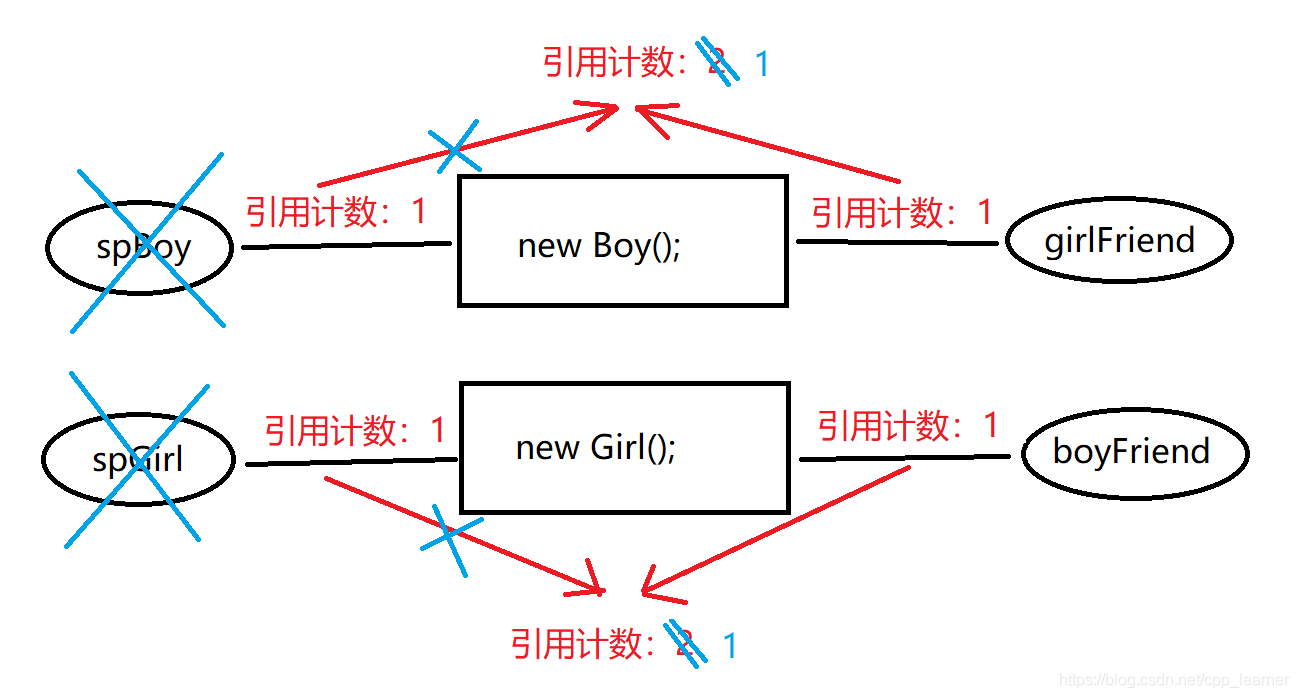
所以在使用shared_ptr智能指针时,要注意避免对象交叉使用智能指针的情况! 否则会导致内存泄露!
当然,这也是有办法解决的,那就是使用weak_ptr弱指针。
针对上面的情况,还讲一下另一种情况。如果是单方获得管理对方的共享指针,那么这样着是可以正常释放掉的!
例如:
void useTrap() {shared_ptr<Boy> spBoy(new Boy());shared_ptr<Girl> spGirl(new Girl());// 单方获得管理//spBoy->setGirlFriend(spGirl);spGirl->setBoyFriend(spBoy);}
反过来也是一样的!
这是什么原理呢?
首先释放spBoy,但是因为girl对象里面的智能指针还托管着boy,boy的引用计数为2,所以释放spBoy时,引用计数减1,boy的引用计数为1;
在释放spGirl,girl的引用计数减1,为零,开始释放girl的内存,因为girl里面还包含有托管boy的智能指针对象,所以也会进行boyFriend的内存释放,boy的引用计数减1,为零,接着开始释放boy的内存。最终所有的内存都释放了。
五、weak_ptr
weak_ptr 设计的目的是为配合 shared_ptr 而引入的一种智能指针来协助 shared_ptr 工作, 它只可以从一个 shared_ptr 或另一个 weak_ptr 对象构造, 它的构造和析构不会引起引用记数的增加或减少。 同时weak_ptr 没有重载*和->但可以使用 lock 获得一个可用的 shared_ptr 对象。
弱指针的使用;
weak_ptr wpGirl_1; // 定义空的弱指针
weak_ptr wpGirl_2(spGirl); // 使用共享指针构造
wpGirl_1 = spGirl; // 允许共享指针赋值给弱指针
弱指针也可以获得引用计数;
wpGirl_1.use_count()
弱指针不支持 * 和 -> 对指针的访问;

在必要的使用可以转换成共享指针 lock();
shared_ptr<Girl> sp_girl;sp_girl = wpGirl_1.lock();// 使用完之后,再将共享指针置NULL即可sp_girl = NULL;使用代码:
shared_ptr<Boy> spBoy(new Boy());shared_ptr<Girl> spGirl(new Girl());// 弱指针的使用weak_ptr<Girl> wpGirl_1;// 定义空的弱指针weak_ptr<Girl> wpGirl_2(spGirl);// 使用共享指针构造wpGirl_1 = spGirl;// 允许共享指针赋值给弱指针cout << "spGirl \t use_count = " << spGirl.use_count() << endl;cout << "wpGirl_1 \t use_count = " << wpGirl_1.use_count() << endl;// 弱指针不支持 * 和 -> 对指针的访问// 在必要的使用可以转换成共享指针shared_ptr<Girl> sp_girl;sp_girl = wpGirl_1.lock();cout << sp_girl.use_count() << endl;// 使用完之后,再将共享指针置NULL即可sp_girl = NULL;当然这只是一些使用上的小例子,具体用法如下:
请看Boy类
#include <iostream>#include <string>#include <memory>using namespace std;class Girl;class Boy {public:Boy() {cout << "Boy 构造函数" << endl;}~Boy() {cout << "~Boy 析构函数" << endl;}void setGirlFriend(shared_ptr<Girl> _girlFriend) {this->girlFriend = _girlFriend;// 在必要的使用可以转换成共享指针shared_ptr<Girl> sp_girl;sp_girl = this->girlFriend.lock();cout << sp_girl.use_count() << endl;// 使用完之后,再将共享指针置NULL即可sp_girl = NULL;}private:weak_ptr<Girl> girlFriend;};class Girl {public:Girl() {cout << "Girl 构造函数" << endl;}~Girl() {cout << "~Girl 析构函数" << endl;}void setBoyFriend(shared_ptr<Boy> _boyFriend) {this->boyFriend = _boyFriend;}private:shared_ptr<Boy> boyFriend;};void useTrap() {shared_ptr<Boy> spBoy(new Boy());shared_ptr<Girl> spGirl(new Girl());spBoy->setGirlFriend(spGirl);spGirl->setBoyFriend(spBoy);}int main(void) {useTrap();system("pause");return 0;}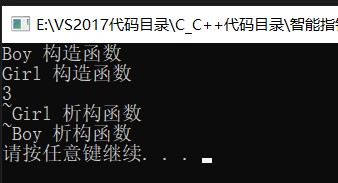
在类中使用弱指针接管共享指针,在需要使用时就转换成共享指针去使用即可!
自此问题完美解决!
六、智能指针的使用陷阱
不要把一个原生指针给多个智能指针管理;
int *x = new int(10);
unique_ptr< int > up1(x);
unique_ptr< int > up2(x);
// 警告! 以上代码使up1 up2指向同一个内存,非常危险
或以下形式:
up1.reset(x);
up2.reset(x);
记得使用u.release()的返回值;
在调用u.release()时是不会释放u所指的内存的,这时返回值就是对这块内存的唯一索引,如果没有使用这个返回值释放内存或是保存起来,这块内存就泄漏了.
禁止delete 智能指针get 函数返回的指针;
如果我们主动释放掉get 函数获得的指针,那么智能 指针内部的指针就变成野指针了,析构时造成重复释放,带来严重后果!
禁止用任何类型智能指针get 函数返回的指针去初始化另外一个智能指针!
shared_ptr< int > sp1(new int(10));
// 一个典型的错误用法 shared_ptr< int > sp4(sp1.get());
关于C++中怎么使用智能指针就分享到这里了,希望以上内容可以对大家有一定的帮助,可以学到更多知识。如果觉得文章不错,可以把它分享出去让更多的人看到。






